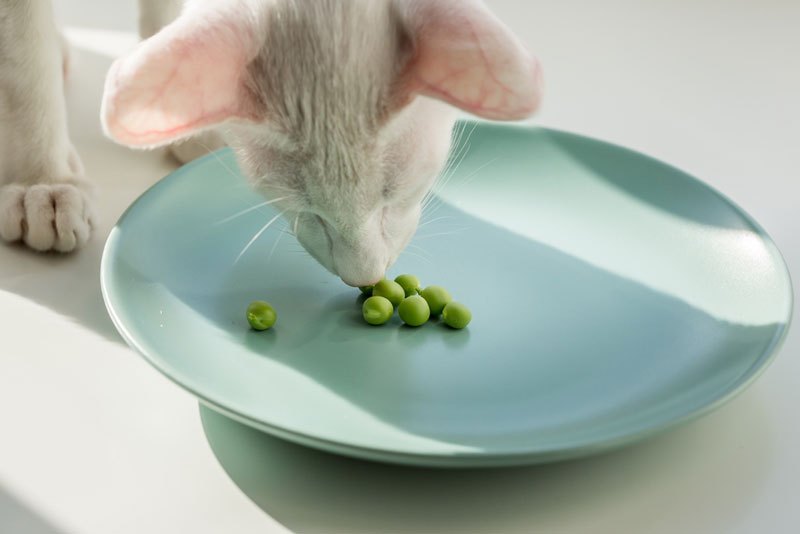Have you ever wondered if our furry friends, the cats, can munch on peas? Well, the answer is yes! Cats can eat peas safely. This delightful little vegetable can even offer some benefits to our feline companions.
Now, before we rush to grab the nearest pea and throw it to Mr. Whiskers, let’s explore a few more details about this green delight. While it may seem unusual to feed our carnivorous cats a plant, peas are packed with nutrients that can supplement their diet in moderation. Who would’ve thought that peas could be a fun twist in our kitty’s meal plan?
So, if you are curious to learn more about how peas can fit into your cat’s life and what benefits they might offer, stick around! We have loads of information to share that will help you become a more knowledgeable pet parent.
You might also be interested in: Can Cats Eat Green Beans?
Can Cats Eat Peas?

When it comes to our cats and their dietary choices, it’s essential to recognize that they are obligate carnivores. This means that their primary nutritional needs are met through meat. However, occasionally introducing vegetables into their diet, like peas, can add some fun variety to their meals. Peas are not toxic to cats, so offering them on occasion is generally safe.
But what about the nutritional value? Peas are an excellent source of vitamins such as A, B, C, and K. They also contain minerals like iron, potassium, and magnesium. These vitamins and minerals can support your cat’s overall health. It’s fascinating considering how picky our feline friends can be! Even with their specific dietary needs, introducing a bit of plant-based food can be healthy.
It’s important to prepare the peas correctly. Fresh or frozen peas are perfect; just cook them briefly to soften them up. Avoid adding any salt or seasoning, as these can be harmful to your pet. The final presentation should be simple, maybe toss a few into their dish as a treat or mash them up if your cat is a picky eater. Moderation is key since too many peas can upset their stomach, causing gas or discomfort. Always keep an eye on how your kitties react when trying new foods! Cats can be quirky, and their preferences may surprise us.
How Much Peas Can Cats Eat?
When it comes to feeding our cats peas, the saying ‘everything in moderation’ rings true. While peas can be a healthy treat, we need to think about portion sizes and frequency. We don’t want to turn our little hunters into green vegetable enthusiasts.
As a general guideline, you might want to offer peas as an occasional supplement rather than a daily staple. A teaspoon or two of cooked peas, mixed in with their regular food, is a great starting point. You can gradually increase the quantity if your cat appears to enjoy them, but always be cautious. Monitoring their reactions and ensuring they stay healthy is crucial. If they start acting strangely, we might need to rethink our green choices!
Now, think of it like our own experiences with food. Some of us might have a favorite dish that we absolutely adore but wouldn’t want to eat it for every meal. The same goes for our pets! A little variation in their diet can enhance their meals without compromising their health. Think of cats and their delicacies – they usually prefer rich, meaty flavors.
We also want to consider that each cat is unique, with different preferences and digestive systems. It’s essential to keep introducing new foods slowly. Introducing peas might take a few attempts before your kitty warms up to the idea. If your cat seems indifferent, their taste buds might not be on board with peas, and that is completely fine!
Let’s not forget that while peas are fun, our cats still require a balanced diet primarily consisting of high-quality animal protein. The peas should not replace their essential nutrients but rather enhance their overall eating experience.
Benefits Of Peas To Cats
1. Nutrient-Rich: One of the standout benefits of including peas as an occasional treat in your cat’s diet is their nutrient density. Peas contain various vitamins and minerals that can boost your cat’s health! For instance, vitamin C plays a vital role in immune function. So, while your kitty primarily thrives on meat, a few peas can serve as an extra layer of protection against common illnesses.
2. Hydration Aid: Peas also have a high moisture content. If your cat is not an enthusiastic drinker, a few peas can help them stay hydrated. Proper hydration is crucial for maintaining kidney health and preventing urinary tract issues. A little pea here and there could encourage your cat to drink more, plus it can add variety to their meals!
3. Fiber Boost: Fiber is an essential aspect of any diet, and peas do not disappoint! They provide dietary fiber that can promote healthy digestion. A good digestive system is vital for our cats, and a small amount of fiber helps keep everything running smoothly. If your cat experiences issues like constipation, a little pea magic might do the trick!
4. Weight Management: As more of us focus on our pets’ weight and health, incorporating low-calorie treats such as peas can be beneficial. They boost the treat options available while remaining low on calories. If your cat could use a little assistance managing their weight, peas can be the perfect substitute for higher-calorie treats that might not offer the same benefits.
5. Variety is the Spice of Life: Finally, let’s face it: cats get bored just like we do! Offering occasional peas as a treat can spice up their dietary routine. It’s essential for a cat’s mental well-being to have both a variety of flavors and textures in their meals. Trying out different foods, like peas, can keep them engaged and excited about mealtime!
Dangers Of Feeding Peas To Cats
Even though peas come with numerous benefits, it’s important to be on the lookout for any potential risks as well. Whenever we introduce new foods to our pets, we must be thoughtful about their well-being. Understanding these risks will help us make informed choices for our feline companions.
The most immediate concern is the possibility of digestive upset. Cats are notoriously sensitive when it comes to any dietary changes. So, if you find your kitty pawing at their stomach after trying peas, it may signal that their tummy is not quite equipped to handle them! Monitor their behavior closely, and if things seem off, it might be best to hold off on those little green delights.
Another aspect to consider is choking hazards. While peas are small, if fed whole, they could pose a risk for some cats, especially those who gulp their food. You could prevent this by mashing them or cutting them in small pieces to avoid any tricky situations. Choking does happen, and we don’t want to put our furry friends in a dicey scenario!
Lastly, we should always be aware of potential allergies. While rare, some cats can be allergic to certain plants, and peas are no exception. If you notice signs like itchiness, hives, or changes in behavior after introducing peas, it’s crucial to consult with your veterinarian. They can help identify the issue and suggest ways to proceed.
In conclusion, while there are risks to consider, most cats can safely enjoy peas in moderation. As attentive pet parents, we should prioritize their health and happiness while enabling them to explore new food adventures!
Substitute Of Peas For Cats
1. Green Beans: If your cat seems curious about vegetables but isn’t fond of peas, consider offering green beans instead! They have similar nutritional benefits and are often loved by cats. Just like peas, green beans are low in calories, rich in fiber, and can assist with digestive health.
2. Carrots: Carrots can be an excellent alternative for those looking to diversify their kitty’s plate! They are rich in beta-carotene and can also aid in healthy vision. Just chop them up and serve them fresh, cooked, or even pureed to entice your picky eater!
3. Pumpkin: This orange wonder is not only a delightful treat but is also packed with nutrients! Pumpkin can aid digestion and provides valuable fiber. If your cat has a bit of a tummy issue, a spoonful of pure pumpkin can soothe and settle it down.
4. Sweet Potatoes: Sweet potatoes can add some sweetness to your cat’s diet without compromising their health. They’re rich in Vitamins A and C and can be prepared similarly to peas. Just make sure they are well-cooked and mashed before serving!
5. Zucchini: Finally, zucchini is another veggie option that many cats find appealing. It’s low in calories, packed with water, and can keep your kitty hydrated! Just slice it up and offer it raw or cooked as a treat.
Can Cats Eat Peas? Frequently Asked Questions
How Often Can My Cat Eat Peas?
Offering peas once in a while is fine! They can be enjoyed as a special treat without becoming a regular part of their diet. Once or twice a week is a good guideline to follow.
Can Kittens Eat Peas?
While it’s typically best to stick to a high-meat diet for kittens, small amounts of peas can be introduced gently after they begin eating solid food. Always consult your vet for advice on specific dietary considerations!
Do Peas Provide Protein For Cats?
Peas do contain some protein, but it’s not as high or complete as the protein found in meat. Since cats thrive on animal protein, peas should be seen as a supplement rather than a primary protein source.
What About Frozen And Canned Peas?
Frozen peas are excellent since they are often flash-frozen at peak freshness, preserving their nutrients. Canned peas can also be okay, but check for added salt or sauces that could harm your cat’s health. Always rinse them well before offering!
Should I Avoid Feeding My Cat Peas Altogether?
No, don’t feel like you need to avoid peas completely! As with many human foods, offering them in moderation is key. Pay attention to how your cat reacts, and proceed accordingly!
Final Thoughts
In the end, feeding our cats peas can be an enjoyable and beneficial experience. With their nutrient-rich profile and potential health perks, they can be a fun addition to your pet’s diet. Always ensure you’re offering them in moderation while keeping a watchful eye on your cat’s response.
As we explore the world of kitty nutrition together, let’s also keep in mind that there are plenty of other exciting food options available, just waiting to be discovered. From delicious homemade meals to safe store-bought treats, it’s essential to provide our cats with a well-rounded diet to support their health and happiness. So let’s keep searching for the best nutrition for our furry family members and create delicious meals that they’ll love!
If you enjoyed learning about peas, feel free to explore more fun topics, such as proper pet nutrition or find out if cats can eat carrots? (spoiler alert: they shouldn’t!). Happy feeding!


